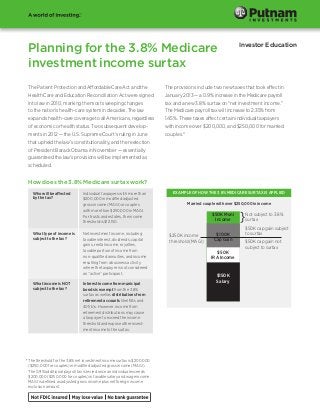
Planning for the Medicare surtax
- 1. Planning for the 3.8% Medicare investment income surtax The Patient Protection and Affordable Care Act and the Health Care and Education Reconciliation Act were signed into law in 2010, marking the most sweeping changes to the nation’s health-care system in decades. The law expands health-care coverage to all Americans, regardless of economic or health status. Two subsequent developments in 2012 — the U.S. Supreme Court’s ruling in June that upheld the law’s constitutionality, and the reelection of President Barack Obama in November — essentially guaranteed the law’s provisions will be implemented as scheduled. Investor Education The provisions include two new taxes that took effect in January 2013 — a 0.9% increase in the Medicare payroll tax and a new 3.8% surtax on “net investment income.” The Medicare payroll tax will increase to 2.35% from 1.45%. These taxes affect certain individual taxpayers with income over $200,000, and $250,000 for married couples.* How does the 3.8% Medicare surtax work? Who will be affected by the tax? What type of income is subject to the tax? What income is NOT subject to the tax? Individual taxpayers with more than $200,000 in modified adjusted gross income (MAGI) or couples with more than $250,000 in MAGI. For trusts and estates, the income threshold is $12,150. Net investment income, including taxable interest, dividends, capital gains, rental income, royalties, taxable portion of income from non-qualified annuities, and income resulting from a business activity where the taxpayer is not considered an “active” participant. Interest income from municipal bonds is exempt from the 3.8% surtax as well as distributions from retirement accounts like IRAs and 401(k)s. However, income from retirement distributions may cause a taxpayer to exceed the income threshold and expose other investment income to the surtax. 1The threshold for the 3.8% net investment income surtax is $200,000 ($250,000 for couples) in modified adjusted gross income (MAGI). The 0.9% additional payroll tax is levied once an individual exceeds $200,000 ($250,000 for couples) in taxable salary and wage income. MAGI is defined as adjusted gross income plus net foreign income exclusion amount. EXAMPLE OF HOW THE 3.8% MEDICARE SURTAX IS APPLIED Married couple with over $250,000 in income $50K Muni Income $250K income threshold (MAGI) $100K Cap Gain $50K IRA Income $150K Salary } Not subject to 3.8% surtax $50K cap gain subject to surtax $50K cap gain not subject to surtax
- 2. Consider investing in municipal bonds As tax rates increase, tax-free municipal bonds are generally more attractive since the tax equivalent yield for taxpayers in higher brackets increases. The tax equivalent yield refers to the yield an investor would require in a taxable bond investment to equal the yield of a comparable tax-free municipal bond. This is a helpful concept to consider when making a decision to invest in a taxable bond or a tax-free bond. As a taxpayer’s tax rate increases, the benefit of the tax equivalent yield also increases. Lastly, since the income threshold for trusts that are subject to the 3.8% surtax is only $12,150, municipal bonds may be an attractive investment option to help avoid the surtax. TAX EQUIVALENT YIELD ON MUNICIPAL BONDS Municipal bond yield 2014 highest rate (43.4%) 3.5% 6.18% 4.0% • Utilize available options to reduce taxable income such as contributing to retirement plans and IRAs, funding Flexible Spending Accounts (FSAs), or contributing to a Health Savings Account (HSA) • Consider other tax-favored strategies to defer income, such as non-qualified annuities, charitable remainder trusts, life insurance, and installment sales • Be mindful of transactions that may increase your overall income above the $200,000 ($250,00 for couples) income threshold such as the sale of highly appreciated assets or a large Roth IRA conversion • If under the $200,000/$250,000 income threshold, consider converting traditional IRA assets to a Roth IRA to create tax-free income for the future (income 7.07% 4.5% Planning strategies that may help investors avoid or mitigate the 3.8% surtax 7.95% from a Roth IRA does not negatively impact calculation of the $200,000/$250,000 income threshold) Consider these risks before investing: Capital gains, if any, are taxable for federal and, in most cases, state purposes. Income from federally tax-exempt funds may be subject to state and local taxes. Bond investments are subject to interestrate risk (the risk of bond prices falling if interest rates rise) and credit risk (the risk of an issuer defaulting on interest or principal payments). Interest-rate risk is greater for longer-term bonds, and credit risk is greater for below-investmentgrade bonds. Unlike bonds, funds that invest in bonds have fees and expenses. Tax-exempt bonds may be issued under the Internal Revenue Code only by limited types of issuers for limited types of projects. As a result, the fund’s investments may be focused in certain market segments and may be more vulnerable to fluctuations in the values of the securities it holds than a more broadly invested fund. Interest the fund receives might be taxable. The prices of bonds may fall or fail to rise over time for several reasons, including both general financial market conditions and factors related to a specific issuer or industry. You can lose money by investing in the funds. Single state investments are at risk of common economic forces and other factors affecting a state’s tax-exempt investments. This may result in greater losses and volatility. This information is not meant as a tax or legal advice. Please consult with the appropriate tax or legal professional regarding your particular circumstances before making any investment decisions. Request a prospectus, or a summary prospectus if available, from your financial advisor or by calling Putnam at 1-800-225-1581. The prospectus includes investment objectives, risks, fees, expenses, and other information that you should read and consider carefully before investing. Putnam Retail Management Putnam Investments | One Post Office Square | Boston, MA 02109 | putnam.comII919 285693 1/14
